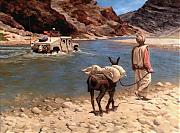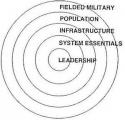By Sean Naylor for the Army times
Liberating Anah
How Apache Company freed an Iraqi city from the grip of a terrorist cell
ANAH, Iraq — insurgents had freely waged a two-year reign of terror on this sleepy, affluent Sunni city of 30,000. They blew up the police station and chased out the nascent police force. They murdered the chairman of the city council and cowed the local populace.
members of Jama’at Al Tawid Al Jihad, known as the JTJ or Group of Monotheism and Jihad — a branch of al-Qaida in Iraq — settled in. This city in central Anbar province came to serve as a convenient sanctuary and way station for fighters going southeast to the real action in Ramadi, Fallujah and Baghdad.
But about 20 kilometers outside Anah, a Stryker squadron commander determined it was time to end the insurgents’ grip on Anah.
Lt. Col. Mark Freitag, commander of the 4th Squadron, 14th Cavalry Regiment, installed a Stryker infantry company in a combat outpost just outside Anah in late March. The grunts of Apache Company, 4th Battalion, 23rd Infantry Regiment, attached to Task Force 4-14, took aggressive action against the insurgents, whose leaders made a move to regain the initiative: They dispatched a shadowy commander named Abu Hamza to take charge of the insurgency in Anah.
The stage was set for a showdown here on the south bank of the Euphrates River.
Steep learning curve
The 131 troops of Apache Company assumed responsibility for Anah and the nearby village of Reyanah on Feb. 2 while still based in Rawah. Theirs was to be a steep learning curve. No coalition forces had been stationed in Anah since the 2003 invasion, and the JTJ was used to having the run of the town.
A few weeks before Apache took over, Freitag himself had detained Sheikh Qatada Sa’ad Tehsin, the city council chairman, for his support of the JTJ. On Feb. 17, the JTJ struck back, gunning down Qatada’s replacement, Sheikh Noori Abdul Fatah Askar, on his way to prayers. Noori was also the senior Anah representative of the Islamic Party, a bitter enemy of the JTJ, and the JTJ blamed him for Qatada’s demise.
Soon thereafter, the city council stopped meeting with Apache troops. “Intimidation was a huge factor in their decision to step away from the table,” said Capt. Matthew Albertus, Apache Company’s commander.
It soon became clear that if Albertus was to have any chance of reversing trends in Anah, he needed to position forces closer to the action. Freitag ordered the establishment of Combat Outpost Anah beside a major intersection just north of the city.
From there, Apache could monitor the main road to Rawah, a favorite insurgent location for roadside bombs. Albertus’ 2nd Platoon and a company-sized Iraqi army element moved in March 25. Albertus also re-established contact with the council, seeking out the members individually.
On April 10, in conjunction with the police training team from TF 4-14, a Stryker unit based in Rawah, Apache held a one-day recruiting drive for local police.Police are the first line of defense in any counterinsurgency campaign, and JTJ’s defeat of the previous attempt to establish a police presence had allowed the insurgents free reign in Anah.
).










Bookmarks